By Roberto Motta
Photos: Ferrari-Media
On Friday, January 28, the presentation of the new Ferrari F150 signaled the start of the new F1 season at Maranello.
The new Ferrari Grand Prix car, born from the Project 662, represents the Scuderia’s interpretation of the technical and sporting regulations that apply this year. The car is officially named F150 as a tribute and celebration of the one hundred and fiftieth anniversary of the Unification of Italy and is a break with the previous naming conventions. The F150 is the fifty seventh Grand Prix car to built by Ferrari specifically to compete in the Formula 1 World Championship.
When you compare it to the old Ferrari F10 model, apparently the biggest changes are the return of the kinetic energy recovery system (KERS) and the new Pirelli tires instead of Bridgestone. After a thirteen year relationship with Bridgestone, this year it is the Italian tire company who will become the sole supplier to Formula 1 for the next three years.
In reality, there are more changes that include a moveable rear wing which allows the drivers to make overtaking easier. The actual aero-package no longer features the famous double diffuser, the flying rear wing and the apertures in the front part of the floor chassis, because they have been eliminated by the new regulations. However, we must underline that Ferrari says that the actual aero-package fitted to the launch model will be significantly altered before the first race in Bahrain.
The F150 uses a new hydraulically controlled adjustable rear wing and the KERS (the KERS is back, thanks partly to the increase in the car’s minimum weight). Other changes include increased cockpit area protection and improved wheel-retaining cables for use in accidents. All of these changes are dictated by the introduction of stricter safety requirements.
The front part of the F150 monocoque is higher than that of the F10 and the front suspension is redesigned. The openings for the side air intakes are smaller, while the layout of the dynamic one above the driver’s head has been modified.
The exhaust system is now similar to that adopted at the end of last season, and the cooling system has been modified because of the return of KERS and of the new air exit ducts. The braking system has been completely redesigned in collaboration with Brembo.
There are relatively few modifications to the 056 engine. However, Ferrari’s specialists continued with engine development with an emphasis to improve reliability. We must emphasize that the reintroduction of KERS has caused a substantial change in the architecture of the front end of the engine, with modifications to the drive shaft system of the KERS itself, and the crankshaft. This in turn has led to changes to the cooling and lubrication systems.
The KERS, designed by Ferrari, was produced in collaboration with MTS and Magneti Marelli and also based on experience acquired in 2009.
The KERS has been been developed with attention to cost reduction, both in terms of its development and the way it is run, so the system will be the same for Sauber and Toro Rosso.
For the early stages of testing, the decision was taken to concentrate on the mechanical components and developing knowledge of the new Pirelli tires, while continuing to push on the development of aerodynamic performance in the wind tunnel.
During the presentation, the Chairman Luca Montezemolo said that he requested the team build a new car which can win immediately. He also commented on the future of a four cylinder Ferrari engine. “I spoke to Todt and I’m glad the there is a different climate of dialogue than in the past. We’re engaged in technological challenges such as the FF: a 4-cylinder Ferrari seems absurd to me. We’ve not even built a 10-cylinder Ferrari and I’m still thinking that a 6-cylinder would have been more in line with the Formula 1 positioning on the market.”
Sergio Marchionne said that he doesn’t exclude the possibility that Alfa Romeo might come back into motorsports. “As far as Alfa is concerned, everything is possible; the brand is extremely sporty and connected to Ferrari since the early days of motorsports”.
Stefano Domenicali commented on the aggressive Formula One program. “We must start well immediately. It’s fundamental, also because if you don’t start gaining points immediately, you can’t recover them later. Naturally at the start there’s a higher possibility to make up for possible mistakes, but the points lost can’t be regained” He continued, “This car is dedicated to celebrations for the 150th anniversary of Italian Unification because it is part of our makeup to feel pride in representing our country all over the world. Even if we have team-members who come from many different countries, starting with a Spaniard like Fernando and a Brazilian, albeit with Italian origins, like Felipe, we have a strong desire to hold high the national flag which is now seen in all its glory on our car. This car is the first step towards that because the car you will see in Bahrain will be completely different from the one you see in the first test week in Valencia. We really want to be successful, and we are more motivated than we have been in the past”.
As to the question “How much of have you contributed to the 2011 F150?” Alonso said. “When I arrived in 2010 I found a very different car compared to the one I had driven before. This year I contributed and I think that also my driving style had an influence on the development. Now I also know the people in my team and I’ve got a good relationship with them and I’m always putting them under pressure”.
Felipe Massa said, “I want to be more competitive from the first to the last race this year and I think that also the Pirelli tires will help me here”.
After a few laps on the Fiornano track, the F150 was loaded onto a truck and will go to Cheste, near Valencia where on Tuesday the development testing will begin. The F150 will be used in the first test with Fernando Alonso at the wheel. He will also drive on the following day. On Thursday 3rd it will be Felipe Massa who will bring to a close the first of four pre-season test sessions.
Despite all the incredible PR (or because of it) at the unveiling, the car does not impress. We are waiting to see the results of the Bahrain Grand Prix.
Technical Specifications
Chassis
— Carbon-fiber and honeycomb composite structure
— Ferrari longitudinal gearbox
— Limited-slip differential
— Semiautomatic sequential electronically controlled gearbox – quick shift
— Number of gears: 7 +Reverse
— Brembo ventilated carbon-fiber disc brakes
— Independent suspension, push-rod activated torsion springs front and rear
— Weight with water, lubricant and driver: 640 kg
— BBS Wheels (front and rear): 13”
Engine
— Type: 056
— Number of cylinders: 8
— Cylinder block in sand cast aluminum V 90°
— Number of valves: 32
— Pneumatic distribution
— Total displacement: 2398 cm3
— Piston bore: 98 mm
— Weight > 95 kg
— Electronic injection and ignition
— Fuel: Shell V-Power
— Lubricant: Shell Helix Ultra
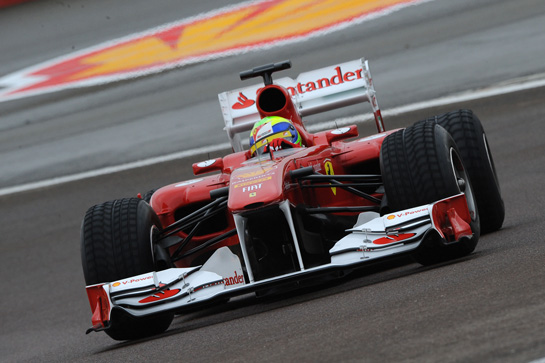
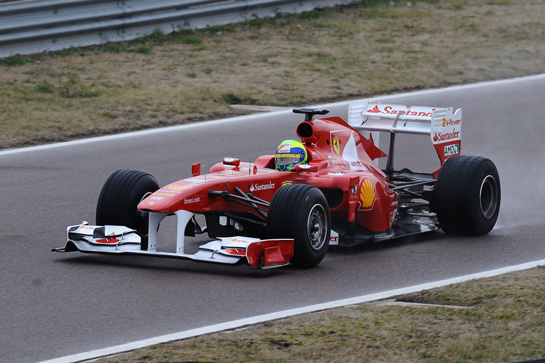
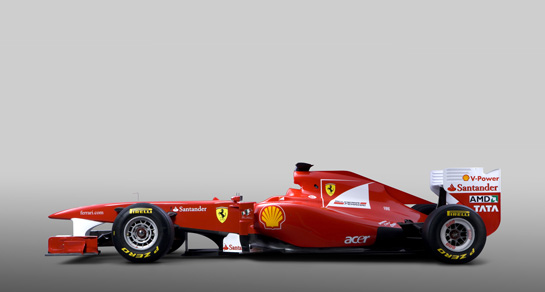
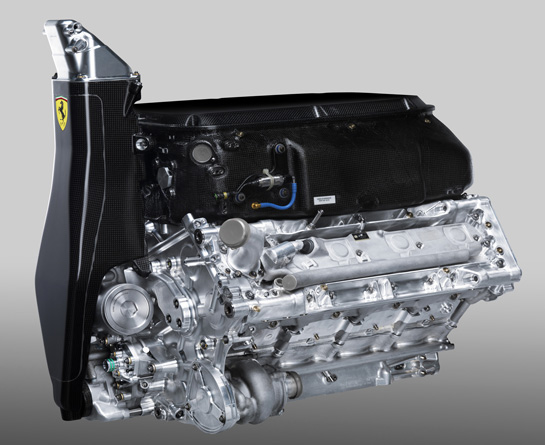
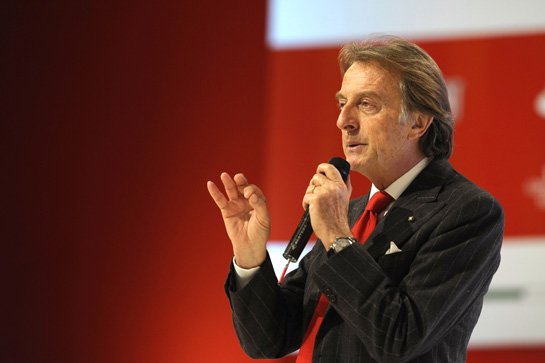
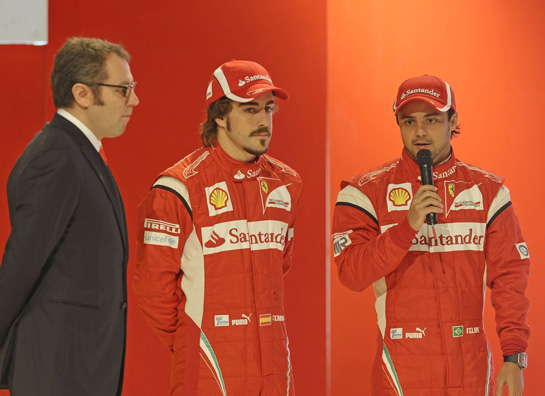
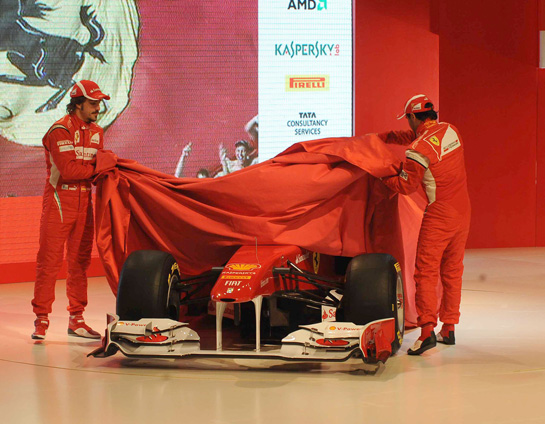
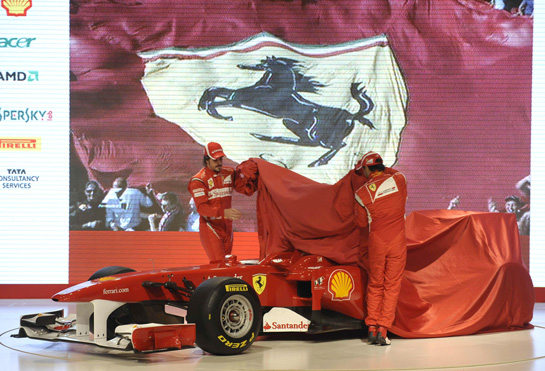
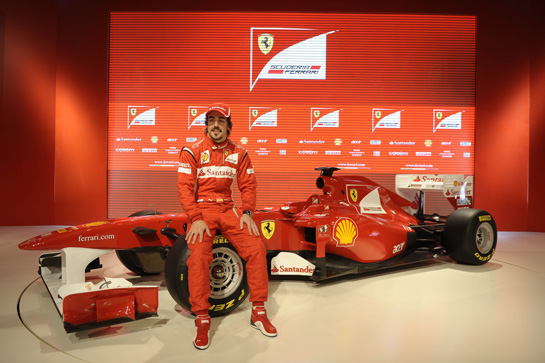
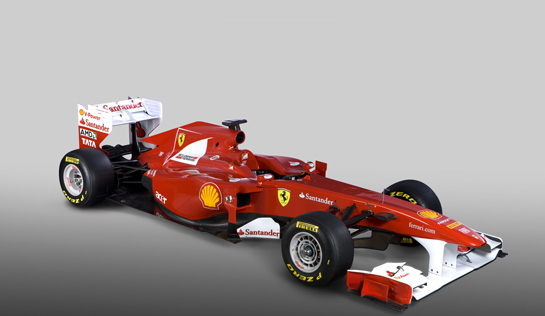
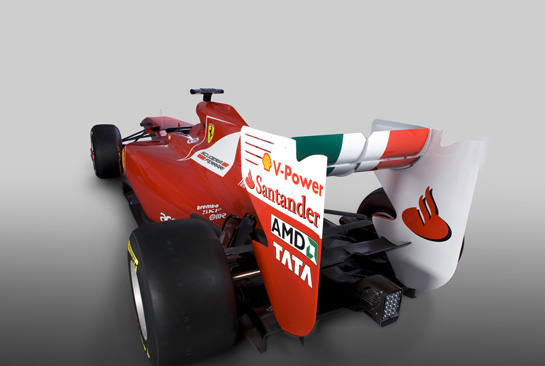
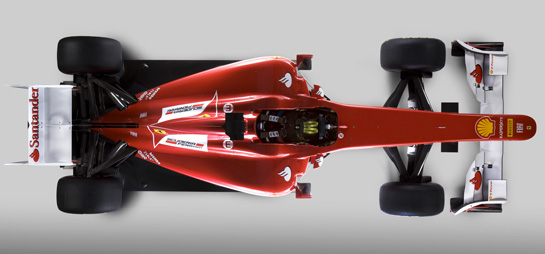
Pinup picturres are great, but the proof will be on the circuit!
Viva Ferrari!
Looks a bit different from Ford’s F150!
The Italian Stallion now sporting Italian Rubber. Nice ….. Makes perfect sense. And it is more appropriate ….